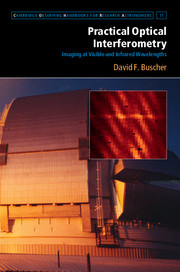Book contents
- Frontmatter
- Contents
- Principal symbols, functions and operators
- List of abbreviations
- Foreword
- Preface
- 1 Making fringes
- 2 Basic imaging
- 3 Atmospheric seeing and its amelioration
- 4 Interferometers in practice
- 5 Measurement noise
- 6 Interferometric observation of faint objects
- 7 Observation planning
- 8 Data reduction
- 9 Model fitting and image reconstruction
- Appendix A Fourier transforms
- Appendix B Supplementary online material
- References
- Index
8 - Data reduction
Published online by Cambridge University Press: 05 August 2015
- Frontmatter
- Contents
- Principal symbols, functions and operators
- List of abbreviations
- Foreword
- Preface
- 1 Making fringes
- 2 Basic imaging
- 3 Atmospheric seeing and its amelioration
- 4 Interferometers in practice
- 5 Measurement noise
- 6 Interferometric observation of faint objects
- 7 Observation planning
- 8 Data reduction
- 9 Model fitting and image reconstruction
- Appendix A Fourier transforms
- Appendix B Supplementary online material
- References
- Index
Summary
The ‘raw’ data from an interferometer consist of the measurements of the fringe pattern plus auxilliary data required for calibration. These data need to be converted into calibrated power spectrum and bispectrum data or coherently-average visibility data for subsequenty model-fitting and image reconstruction. The exact details of the data-reduction process varies between interferometric instruments and typically software is provided for each instrument that can perform the major parts of the process. This chapter provides an outline of what is going on inside this software in order to provide an understanding of the processes and the rationale for choosing one process over another when analysing a given dataset.
Scientific inference
The data-reduction process is part of a larger process, which aims to gain some knowledge about the astronomical object under investigation based on measurement of fringe patterns, and it is helpful to consider the process as a whole to understand where data reduction fits in.
The process of gaining knowledge based on measurements is known as scientific inference. A conceptual model of scientific inference starts out with an existing state of knowledge. This can be cast in terms of a model of the object, which has a number of unknown parameters. An example model is a binary star system consisting of a pair of stars with unknown brightnesses and diameters for the constituent stars and an unknown separation between them.
A particular set of values for all the model parameters can be thought of as representing a single point in a multi-dimensional space known as the model space. For a particular point in model space, the set of fringe measurements that would be produced by a given interferometer represents a point in the data space of the instrument. This model of inference is shown diagramatically in Figure 8.1.
- Type
- Chapter
- Information
- Practical Optical InterferometryImaging at Visible and Infrared Wavelengths, pp. 194 - 217Publisher: Cambridge University PressPrint publication year: 2015



